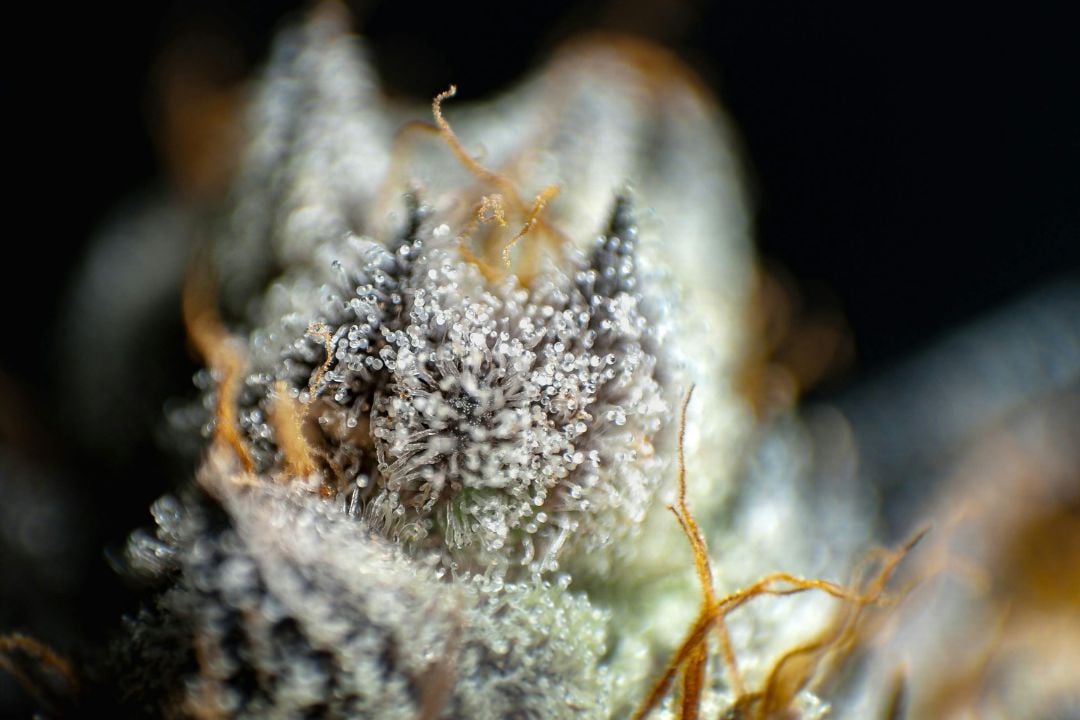When people say “terps” in weed, they’re talking about terpenes, the natural compounds that give cannabis its smell and flavor. They’re what make one cultivar smell like citrus and another like pine or diesel.
Terpenes shape more than just the scent. They influence how a cultivar feels and can make the same THC level hit differently depending on the mix. A strain rich in limonene might feel bright and upbeat, while one high in myrcene could lean more chill.
Learning about terps helps you pick cannabis that fits your vibe. Once you start paying attention to them, you’ll notice patterns in the cultivars you love and can use that knowledge to fine-tune your sessions.

What Are Terpenes?
Terpenes are aromatic compounds that show up in tons of plants, not just cannabis. They’re responsible for the way pine trees smell fresh, lavender feels soothing, and citrus peels burst with zest. In weed, terpenes are what make each cultivar smell, taste, and hit differently.
At their core, terpenes are part of a plant’s natural defense system. They help attract pollinators and keep pests away. In cannabis, those same compounds end up influencing the experience for the user. Different combinations of terpenes create distinct scent profiles and effects, which is why two cultivars with the same THC percentage can feel completely different.
You’ll find some of the same terpenes in other familiar plants and foods. Myrcene shows up in mangoes, limonene in lemons, and pinene in pine needles. So when you smell weed that reminds you of a forest, fruit bowl, or spice rack, you’re really picking up on its terpene mix.
Common Terpenes Found in Cannabis
Each cannabis cultivar has its own terpene fingerprint. Some terpenes show up more often than others, and once you get familiar with them, you can start predicting how a strain will smell, taste, and feel. Here are a few of the main players.
Myrcene
Earthy and musky with a hint of sweetness, myrcene is one of the most common terpenes in cannabis. It’s found in mangoes and hops, and it often shows up in cultivars known for their mellow effects.
Limonene
Bright and citrusy, limonene gives certain cultivars that zesty lemon or orange aroma. It’s linked to an uplifting vibe and often appears in fruity or tropical weed.
Linalool
Floral and slightly spicy, linalool is the same compound that gives lavender its soothing scent. Strains with linalool tend to carry a calm, relaxed energy.
Pinene
Crisp and sharp, pinene smells like a walk through the woods. It’s one of the most abundant terpenes in nature and can add a refreshing twist to a strain’s flavor.
Caryophyllene
Spicy and peppery, caryophyllene is found in black pepper and cloves. It’s unique because it interacts with some of the same receptors as cannabinoids, adding a little extra depth to a cultivar’s effects.
Terpinolene
Sweet, herbal, and a bit fruity, terpinolene tends to show up in cultivars with a more energetic or creative feel. It’s less common but loved by people chasing complex aromas.
Ocimene
Fresh and slightly sweet, ocimene adds a fruity, woody layer to certain cultivars. It’s also found in mint, basil, and orchids, giving it a light, refreshing edge.
Together, these terpenes make up the scents and flavors that define your favorite weed. Whether you lean toward citrus-heavy sativas or earthy indicas, the terps are what make each experience unique.

How Terpenes Affect Your Weed Experience
Terpenes don’t just make weed smell good. They help shape the overall experience. The mix of terpenes and cannabinoids like THC and CBD changes how each cultivar feels, tastes, and even how long its effects last.
This interaction is often called the entourage effect. It’s the idea that cannabis compounds work better together than on their own. A strain high in pinene and THC might feel clear-headed, while one with myrcene and the same THC level might feel more laid-back. The terpenes guide the tone of the high.
Some terpenes lean bright and energizing, like limonene or terpinolene. Others, like linalool and myrcene, create a more chill and soothing experience. That’s why two cultivars with similar THC numbers can feel completely different once you smoke them.
When you start noticing how certain terps affect your vibe, it becomes easier to find weed that matches your mood. Whether you want to kick back or stay creative, paying attention to terpene profiles helps you get exactly what you’re looking for.
How to Identify Terpenes in Cannabis Products
You don’t need to be a scientist to figure out which terpenes are in your weed. Most licensed products today list terpene profiles right on the label or in the lab results. Once you know what to look for, reading those details can tell you a lot about the kind of experience you’re buying.
Reading the label
Dispensary packaging often lists the dominant terpenes, along with their percentages. If you see limonene, expect something citrusy and upbeat. If you see myrcene, you’re probably looking at something smooth and relaxing.
Checking the lab report
Lab-tested cannabis shows more than just THC and CBD. The terpene section usually lists the top compounds by weight or percentage. This helps you understand why certain strains smell or feel the way they do.
Trust your nose
Even without lab data, your senses can give you clues. A gassy, piney aroma points toward pinene or caryophyllene, while something floral or fruity probably has linalool or limonene in the mix.
Since terpene levels change depending on how the plant is grown and cured, two batches of the same cultivar can have slightly different profiles. Smelling your weed before you buy it (when possible) or checking the latest lab test helps you pick the one that fits your mood best.

Terpenes in Concentrates, Edibles, and Vapes
Terpenes aren’t just in flower. They play a huge role in concentrates, vapes, and edibles too, but how much of their original aroma and flavor survives depends on the production process.
Extraction and preservation
Heat and pressure can change or destroy terpenes, so the extraction method matters. Live resin and live rosin are known for keeping a strain’s natural terpene profile because they’re made from fresh-frozen plants instead of dried ones. On the other hand, high-heat extraction methods can strip away many of those delicate compounds.
Added vs. natural terpenes
Some vape carts and edibles include added terpenes. These might be cannabis-derived, meaning they come from the plant itself, or botanical, which means they’re sourced from other plants like lemons or lavender. Added terpenes help restore aroma and flavor that might have been lost during processing.
Product types that keep the flavor
If you’re chasing rich, full-bodied flavor, look for products labeled “live” or “full-spectrum.” These keep more of the natural terpenes intact. Vape carts that list specific terpenes are usually a good sign too.
Whether you’re puffing on flower, taking a dab, or eating an edible, terpenes shape the flavor, smell, and overall experience. Knowing which extraction styles preserve them helps you pick products that stay true to the original cultivar.
Why Terpenes Are Gaining Popularity
Terpenes have gone from being a science term to a buzzword among cannabis fans. People are realizing that THC percentage isn’t the whole story. The aroma, flavor, and vibe of a cultivar often come down to its terpene mix, which is why more growers and buyers are paying attention to them.
Terpene-forward strains
Breeders are creating cultivars that highlight bold, memorable terpene profiles. Instead of chasing the highest THC number, more people want weed that smells incredible and feels balanced.
Craft cannabis culture
Small-batch growers are focusing on terpene-rich cultivation. They use careful drying, curing, and storage methods to protect delicate terpenes from heat or light. The goal is to keep the full scent and flavor of the flower alive.
Terpenes in marketing and competitions
Dispos and brands now highlight terpenes like flavor notes on a wine bottle. Cannabis cups and competitions often give awards for “Best Terp Profile,” recognizing growers who bring out rich and layered aromas.
All this love for terpenes makes sense. When you start choosing weed for how it smells and tastes, you begin to appreciate the plant in a whole new way. It turns smoking or vaping into a sensory experience instead of just a high.
Understanding Terps Means Better Weed Choices
Once you understand terpenes, shopping for weed gets way easier and way more fun. Instead of guessing based on THC numbers or flashy names, you can pick cultivars that actually match what you want from your session.
If you love bright, fruity aromas, you might gravitate toward limonene-heavy cultivars. If you prefer earthy or musky notes, myrcene-rich flower could be more your thing. Over time, you’ll start recognizing which terps hit the way you like, helping you find new favorites faster.
Learning about terpenes gives you control over your experience. It helps you predict how a strain will smell, taste, and feel before you even light it. Choosing weed based on terps allows you to curate your own perfect lineup of flavorful flower.
FAQs About Terpenes in Cannabis
Terpenes are the natural compounds that give cannabis its smell and flavor. They’re what make one cultivar smell fruity, earthy, or like pine.
Yes. Terpenes work with cannabinoids like THC to shape the overall vibe of a cultivar. They can make one strain feel energetic and another more relaxing.
Some of the most common terpenes include myrcene, limonene, pinene, linalool, and caryophyllene. Each one brings a unique aroma and influence on the experience.
Many licensed products list terpene profiles on the label or lab report. You can also trust your nose—sweet, citrusy, or earthy scents reveal the dominant terps.
Yes, but it depends on how they’re made. Products like live resin or live rosin keep more of their original terpenes, giving you richer flavor and aroma.
More people are realizing that THC percentage isn’t everything. Terpenes shape the scent, taste, and feel, helping you find cultivars that match your mood.









